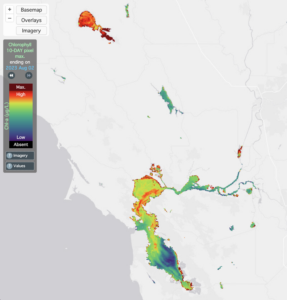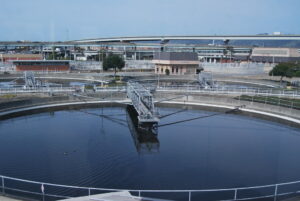Beth Huning’s current position as Coordinator of the San Francisco Bay Joint Venture isn’t her first role in the field of wetlands conservation, but it certainly is one that brings together her passion for birds, her commitment to environmental protection, and her ability to work well with people representing many different constituencies. That’s essential when running a consortium of over 26 groups, all focused on the preservation and restoration of San Francisco Bay’s tidal wetlands to benefit bird, fish, and other wildlife populations. Just this month the Joint Venture celebrated its 15th anniversary. Beth is also a talented nature photographer: last year she was awarded the North American Nature Photography Association’s Philip Hyde Grant Award for conservation photography.
BN: How long have you lived in the Bay Area?
BH: My family is originally from the Bay Area, but I have lived in several other areas of California, including several years as a naturalist in Yosemite National Park. I returned to my family roots here almost 30 years ago to become the Director of the Richardson Bay Audubon Center and Sanctuary. I managed the waterfowl sanctuary and education program there until about 10 years ago.
BN: Tell us a bit about the SF Bay Joint Venture and how you got involved with it.
BH: The Joint Venture is a voluntary partnership of public agencies, environmental organizations, landowners, and businesses that collaborate on bringing back wetlands and targeted wetland species. There are 18 other federally-supported habitat Joint Ventures around the United States, formed in response to the North American Waterfowl Management Plan and other federal bird conservation plans. Our main focus is habitat for birds and other wildlife. There are 200,000 acres of various types of wetlands within our target area. Because it’s non-regulatory, the Joint Venture’s decisions are not binding, but we do provide recommendations that help the partners move forward with habitat planning, project implementation, and monitoring.
I’ve been involved with the Joint Venture from the very beginning: While I was working at Audubon, I was one of the founding partners of the Joint Venture, and later became its third chair. I later moved from the volunteer role of Management Board partner to the staff position of Coordinator, a position I’ve held for almost 10 years now. It’s an honor to work with so many dedicated partners who are making a difference for wildlife and habitat.
BN: The first State of the Birds report, released last week, seems to contain some good news and some bad news about Bay Area resident and migratory birds. What are your main observations/takeaways from it?
BH: The report verifies the role of conservation and the importance of a strong commitment to protecting species and habitat. While there are listed species that will continue to need special management to ensure their recovery, bird populations in the Bay Area are fairly stable thanks to ongoing conservation efforts by our partners and others. The common goals established through the Joint Venture have led to significant habitat gains and have probably kept some species from declining. We need to continue on the trajectory of habitat protection and management to ensure that birds can still thrive as they nest, migrate or winter here.
BN: What are the main challenges for Bay Area bird populations?
BH: Bay Area birds face numerous challenges. We have several species such as the California Clapper Rail and Western Snowy Plover that live here that are listed as endangered. These species are not yet recovered. Many of the birds we see in the Bay Area are migratory and winter here or forage as they move through on their way to other places. Habitat conversion is the big challenge. This can include anything from commercial development to changing agricultural uses, to invasive weeds. Nonnative predators such as free-roaming house cats also pose a big threat to native birds. And now there is climate change, which will cause sea level to rise and changes in vegetation in upland habitats and along the shorelines. Joint Venture partners are trying to plan for that, to make habitat available for shorebirds and water birds as sea level rises over the next 50-100 years.
BN: Tell us about your passion for birding.
BH: The Bay Area is rich in bird species as well as birding opportunities. I live in West Marin, and I have great birding right at home – Pileated and Acorn Woodpeckers, warblers, and many other birds. This year two Turkey Vulture chicks were raised and fledged right off my back deck. It was fun to watch them for a couple of weeks as they emerged as fluffy chicks until they were able to fly on their own. I would encourage people to visit the Joint Venture outreach website to hear our podcasts about where to see birds. We just posted one about the birds that are migrating into the area now and will be here through the winter.
BN: Where are some of your favorite places to go in nature in the Bay Area?
BH: I love the Point Reyes area because of the diversity and the presence of species you won’t see in other locations. The Marin Headlands in the fall is one of the best places anywhere to see raptors. And birding along the shoreline of the Bay can be rewarding as the wetlands and mudflats are rich with shorebirds, especially now.
Learn more about the SFBayJV here:
>> More information about the Joint Venture, its partners, its newly-released 15-year retrospective covering all 140 completed projects, and progress toward its goals can be found on the SFBayJV’s web site, www.sfbayjv.org
>> Download The SFBayJV’s audio tours of places to go birding in both the North Bay and South Bay at www.yourwetlands.org.

.jpg)



